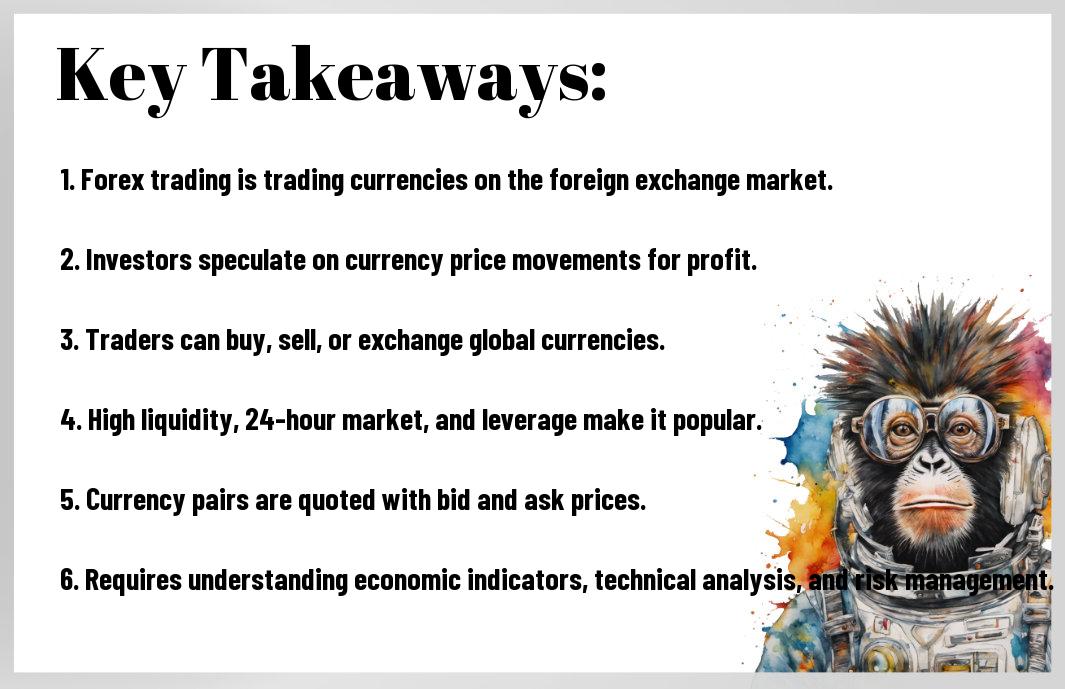The foreign exchange market, more commonly known as Forex trading, is the world’s largest financial market, with trillions of dollars traded daily. In this market, currencies from around the globe are bought and sold, with the aim of profiting from fluctuations in exchange rates. Forex trading can be highly volatile and risky, with the potential for significant financial gains, but also the possibility of substantial losses. Traders can take advantage of leverage to amplify their gains, but this also increases their exposure to risk. Understanding market dynamics, utilizing technical analysis, and staying informed about economic events are crucial for success in Forex trading. By engaging in this global market, traders can benefit from opportunities to profit from the constant movement of currency prices.
Key Takeaways:
- Forex trading involves the buying and selling of currencies on the foreign exchange market.
- Currency pairs are traded in the forex market, with the most commonly traded pair being the EUR/USD (euro/US dollar).
- Forex trading works 24 hours a day, five days a week, allowing traders to take advantage of global market movements and fluctuations in currency prices.

The Basics of Forex Trading
Understanding Currency Pairs
One of the fundamental concepts in forex trading is understanding currency pairs. In the forex market, currencies are always traded in pairs, such as EUR/USD or GBP/JPY. The first currency in the pair is the base currency, while the second currency is the quote currency. The value of a currency pair indicates how much of the quote currency is needed to purchase one unit of the base currency.
The Mechanics of a Forex Trade
With forex trading, you are vitally buying one currency while simultaneously selling another. When you open a trade, you speculate on the direction in which you believe the exchange rate will move. If you believe the base currency will strengthen against the quote currency, you buy the pair, and if you think it will weaken, you sell the pair. The goal is to make a profit by closing the trade at a higher price than the entry price.
For instance, it is important to note that leverage is commonly used in forex trading, allowing traders to control a larger position with a smaller amount of capital. While leverage can amplify profits, it also increases the risk of significant losses. It is crucial for traders to have a solid risk management strategy in place when trading forex.
Analyzing the Forex Market
Fundamental Analysis
Forex traders often rely on fundamental analysis to evaluate a currency’s intrinsic value. This analysis involves assessing various economic indicators, such as GDP, interest rates, inflation, and political stability, to determine a currency’s strength or weakness. Understanding fundamental analysis is crucial as it provides insight into long-term trends and helps traders make informed decisions.
Technical Analysis
For traders looking for more immediate insights, technical analysis plays a key role in analyzing the Forex market. This method involves studying historical price data, charts, and volume patterns to predict future price movements. Technical analysis helps traders identify trends, support and resistance levels, and potential entry and exit points for trades.
This method is not foolproof and carries risks, but when used in conjunction with other forms of analysis, it can provide valuable information for traders. It’s important to understand that technical analysis is more of an art than a science, as it relies on interpreting market psychology and behavior.
Forex Trading Strategies
Unlike What Is Forex Trading? A Beginner’s Guide, where the focus is on understanding the basics of the forex market, Forex Trading Strategies investigate into the various methods traders use to make informed decisions and navigate the unpredictable currency exchange landscape.
Position Trading
An effective strategy for traders with a long-term perspective, position trading involves holding trades for weeks, months, or even years. Traders analyze fundamental factors, economic indicators, and geopolitical events to identify trends and make calculated decisions on when to enter and exit positions. This strategy requires patience and discipline but can result in significant profits for those who master it.
Day Trading and Scalping
Strategies like day trading and scalping involve making multiple trades within a single day to capitalize on short-term price fluctuations. These strategies require quick decision-making, a deep understanding of technical analysis, and the ability to control emotions under high-pressure situations. Day traders typically close out all positions by the end of the trading day, while scalpers aim to profit from small price movements throughout the day. While these strategies can be highly profitable, they also carry a high level of risk due to the volatile nature of the forex market.
Risks and Risk Management
Common Risks in Forex Trading
Trading in the forex market comes with inherent risks that every trader should be aware of. These risks include currency fluctuations, geopolitical events, interest rate changes, and market volatility. It is important to understand that the forex market operates 24 hours a day, five days a week, making it susceptible to sudden and unexpected changes.
Implementing Effective Risk Management
Forex traders can mitigate the common risks associated with currency trading by implementing effective risk management strategies. This involves setting stop-loss orders to limit potential losses, diversifying the portfolio to spread out risk, and staying informed about global economic events that could impact currency values. Additionally, traders should also consider using leverage cautiously to avoid excessive losses.
Understanding that the forex market is highly volatile and speculative, traders must exercise caution and discipline in their trading approach. By employing sound risk management techniques, traders can protect their capital and enhance their chances of long-term success in this challenging yet rewarding market.
Getting Started with Forex Trading
Choosing a Forex Broker
Choosing the right forex broker is crucial when starting your forex trading journey. Look for a broker that is regulated and has a good reputation in the industry. Consider factors such as fees, available currency pairs, trading platform, and customer support. Ensure the broker is well-established and has a user-friendly platform that meets your trading needs.
Essential Tools and Platforms
On your way to becoming a successful forex trader, having the right tools and platforms is imperative. You will need a reliable internet connection, a computer or mobile device, and a trading platform provided by your broker. It is important to familiarize yourself with the platform and its features to make informed trading decisions.
Plus, consider using additional tools such as technical analysis software, economic calendars, and news sources to help you analyze the markets and make profitable trades. Staying informed and using the right tools can give you an edge in the forex market.
Summing up
With these considerations in mind, forex trading can be defined as the buying and selling of currencies in the foreign exchange market. This global decentralized market operates 24 hours a day, five days a week, allowing traders to speculate on the fluctuations in currency prices. Forex trading involves the use of leverage, enabling traders to control larger positions with a smaller amount of capital. By analyzing economic indicators, geopolitical events, and market trends, traders can make informed decisions to profit from currency movements. It is necessary for traders to understand the risks involved in forex trading and develop a solid trading strategy to navigate this dynamic market successfully.
FAQ
Q: What is forex trading?
A: Forex trading, also known as foreign exchange trading, is the process of buying and selling currencies in the foreign exchange market with the goal of making a profit. Traders speculate on the price movements of currency pairs, such as EUR/USD or GBP/JPY, and aim to capitalize on these fluctuations.
Q: How does forex trading work?
A: Forex trading works by traders participating in the global currency market where currencies are exchanged 24 hours a day, five days a week. Through a broker, traders can open positions to buy or sell a currency pair based on their analysis and market insights. Profits are made by accurately predicting the direction in which a currency pair’s price will move.
Q: What are the key factors that influence forex trading?
A: Several factors influence forex trading, including economic indicators, geopolitical events, central bank policies, and market sentiment. Traders analyze these factors to make informed decisions about when to enter or exit trades. Additionally, factors such as leverage, margin, and risk management play crucial roles in forex trading success.
